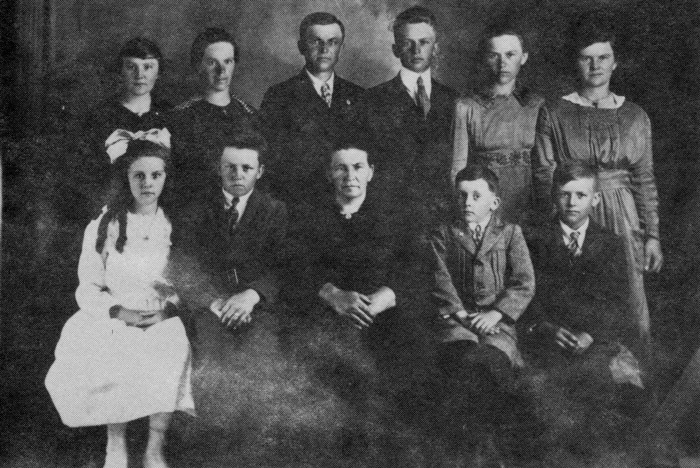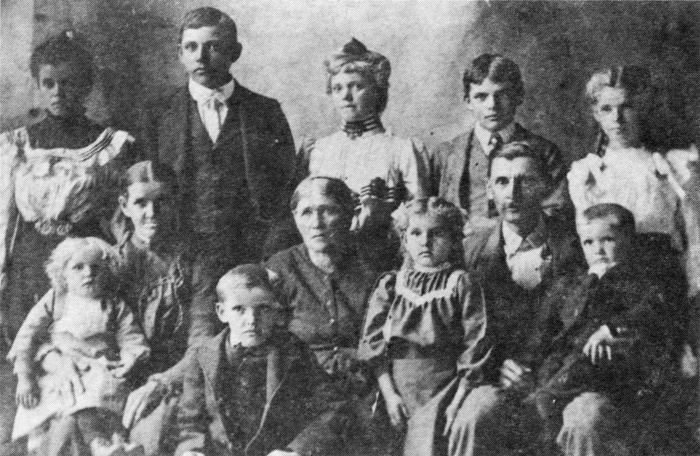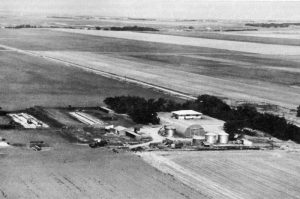Reverend Steve Parke
Published in the Journal of the American Historical Society of Germans From Russia,
Vol. 14, No. 2 – Summer 1991, pp. 24 – 30
Posted with permission of the author, July 6, 2002

I first became interested in genealogy about six years ago through Fr. Richard O’Toole, a relative on the paternal Irish side of the family. From here I expanded my research to my maternal line of Nemechek-Schuster ancestors from Bukovina. Part of the process included interviews with some relatives who, because of their age, knew considerably more than I. Among these was Mary Sanders, my grandfather’s sister, who at the time of the interview in 1986, resided at the St. John’s Home in Hays, Kansas. She was rather friendly, bright, and talkative at the time, but has since passed on. While we chatted she spoke of the fond recollections of Bukovina cherished by her sister, Apollonia Nemechek. Born in 1886, Apollonia came to Ellis County in 1898 at the age of twelve, with her grandmother, parents, and seven brothers and sisters. She remembered Bukovina and spoke of it often, especially of the beauty of the old country, its trees, grass, and rolling hills. The plains of Kansas were a stark contrast to the Carpathian Mountains which had been her home.
Descendants of Bukovina have lived in western Kansas for over a century. We remember, study, and celebrate the rich cultural heritage they brought with them and have transmitted to us. We extend our remembrances, and acknowledge and celebrate the land to which these people immigrated and on which they have left an imprint: the Great Plains. Just as the land and the beauty of Bukovina were meaningful to Apollonia, the Great Plains were very important to our ancestors and continue significantly to influence our existence today.
We all know that a special bond exists between the land and the people who dwell on it; this is especially the case for the inhabitants of the Great Plains. This flat, treeless, semi-arid region has impacted the descendants of Bukovina for over a century. Hopefully this article will afford the reader at least a glimpse of the interaction between the land and its tillers since the first Bukovina colonists settled in Ellis County in 1887.
For me this is a very personal subject, since I was born in Trego County, a descendant of Bukovinian immigrants. Now I live on the eastern High Plains of Colorado. Somewhat analogous to my ancestors, I have spent a number of years moving out, exploring, and taking risks in places other than the High Plains. One thing I have learned is that we cannot escape our history or the influence of our traditions. More specifically, we cannot ignore the experiences of our forebears in Bukovina and on the Great Plains where they have lived for the past hundred years. Their legacy is cultural, spiritual, familial, and economic. Now let us take a closer look at our heritage as shaped by Bukovina and the Great Plains.
Permit me first to clarify the concept of the Great Plains. Geographically this area extends from the Rio Grande River on the Texas-Mexican border to the vast unforested plains regions of Canada on the north/south axis. The eastern boundary is more difficult to identify and depends on one’s north-south reference point. Anyone who has driven across Kansas knows that the land starts to look different once you are west of Salina, which puts us at 98 degrees west longitude. For our purposes this point of reference will suffice as an eastern boundary.
Historically speaking, the Great Plains is that area first occupied by the Plains Indians and the roaming buffalo. The Spanish did some exploration here as early as the 1500s. In the early 1800s trappers, traders, and mountain men moved into the region. They were followed by the European immigrant farmers and town dwellers who in the last century introduced to the High Plains the agriculture we now know in western Kansas.
These Great Plains did not exist in a vacuum on the international scene. While history took its inexorable course on the Great Plains, events were occurring almost halfway around the world in Austria and its easternmost province, Bukovina, which were later to bring together the peoples and cultures of these two lands. Let us look at some of the parallels of the history of these two areas: Austrian Bukovina and the American Great Plains.
In the late 1700s both these places were rather sparsely populated with the Plains buffalo outnumbering human inhabitants of both regions combined. In neither locality had European people, cultures, or industrialization begun to play a significant role. But the late 1700s was a time of transition. With the 1775 cession by the Turks of Bukovina to Austria during the reign of Empress Maria Theresa, the newly-acquired Habsburg province began to attract colonists and undergo economic transformation. Meanwhile, in 1776, the Continental Congress signed the Declaration of Independence, giving birth to a new political reality on this continent.
In 1803, Fürstenthal, the village in Bukovina of my German Bohemian ancestors, was founded in the wooded forests near Radautz. In that same year the United States purchased the Louisiana Territory from France and our Great Plains were incorporated into the American republic. The year 1803 also witnessed the inception of the Lewis and Clark Expedition which, endorsed by President Thomas Jefferson, crossed the Great Plains and proceeded across the Rocky Mountains, reaching the mouth of the Columbia River by 1805.
The early nineteenth century was a time of exploration and settlement. From 1775 to 1843 some 3,000 state-sponsored colonists pioneered in Bukovina. At the same time North American trappers, traders, and farmers moved into the Great Plains, seeking to sustain themselves by their frontier skills and the sweat of their brows. Others passed through this land on the Oregon and the Santa Fe trails for points further west.

By the 1840s the seeds of transition had been sown in both lands. At this time migration to Bukovina slowed; and with the decline of the retail price of pelts, so did the American mountain men’s fur trade. In 1846 the United states annexed Mexican lands from the boundary of the Louisiana Territory to the Rio Grande River. The following year the Plains Indians, feeling threatened in their habitat, began to offer increased resistance to white settlements.
As we proceed into the 1860s we encounter other changes. Politically, the Austrian Empire of the Habsburgs, after its defeat in the Seven Weeks’ War with Prussia, made an accommodation with its most active minority and in 1867 reconstituted itself as AustriaHungary. This compromise, intended to provide stability to a fragile empire torn by regional and ethnic loyalties, functioned reasonably well until World War I. But economically our forebears in Bukovina found it increasingly more difficult to eke out an existence. By the last decades of the nineteenth century a population explosion and limited opportunity for social and economic mobility had begun to impact on their livelihood.
Meanwhile in the United States, and in particular on the Great Plains, new doors were opening for settlers. The Civil War (1861-1865) reunited North and South: moreover, through the 13th, 14th, and 15th Amendments to the Constitution, the nation’s slave population gained personal freedom, due process of law, and citizenship. With the Homestead Act (1862), large tracts of land were opened for settlement on the Great Plains. Merely by residing there and farming it for five years, homesteaders could acquire clear title to 160 acres of land. The completion of the transcontinental railroad in 1869 served as a boon in opening the Great Plains for settlement and commerce.
Although the twenty-five year period following the Civil War witnessed great economic, political, cultural, and demographic changes in our country, time will not permit us to explore them further. Rather, for our purposes now, a look at the challenges, ethos, and legacy of our forebears will be more appropriate. The land and the problems of its earlier inhabitants are still with us today, as the following examples demonstrate.

Transportation presented a challenge on the Great Plains a hundred years ago as it still does now. In earlier days trails had first to be blazed across virgin land which lacked readily available sources of water: Because of the great distances between settlements and the hardship of travel, relatives did not see each other often: The loneliness of the Great Plains represented a stark contrast to the closely-knit community life in the villages of Bukovina and may well have been the settlers’ first culture shock in the New World:
Although today we can whisk about from one town to another on our superhighways, transportation is still a problem: Not only is it expensive to maintain our modern road system, we are finding that emissions from our motorized vehicles are hazardous to both the environment and to human life: This is obviously not just a problem confronting the Great Plains: It affects us all since our industrialized society is so dependent on rapid transit.
Achieving a sustainable level of agricultural production has always presented a challenge for the tillers of the Great Plains: Farming here is significantly different than across the seas in the wooded hills of Bukovina. Nor does it bear much resemblance to farming in the rich wetlands of the eastern United States: Unable to withstand the rigors of the Dust Bowl, many simply moved on: Abandoned homesteads and bankruptcies stand as testimony to failed attempts to strike roots in middle America.
Modern farming and ranching methods had to be developed and applied in order for the homesteads to remain economically viable. Just as the Canadian farmer, Angus Mackay, introduced the practice of summer following in 1885, High Plains farmers began using large sweeps on stubble mulchers or undercutters in the latter half of this century to save topsoil, ground moisture, and stubble. Farmers are today experimenting with a variety of herbicides. As in earlier days, the struggle to maintain economically and environmentally sustainable agriculture continues unabated.
The problem of water has always stalked the Great Plains. In the absence of abundant surface water in this area, early explorers and trail breakers followed the course of the rivers. How many of our ancestors suffered from thirst or actually died because of a lack of water we will never know. Fortunately for our immediate Bukovina progenitors windmill manufacturing had reached significant production levels by 1873 and windmills were available when they arrived.
The availability of an adequate water supply still haunts the inhabitants of the Great Plains. Just recently a Hays, Kansas radio announcer reminded the listeners of the restrictions on lawn watering, while a Garden City, Kansas radio broadcaster reported that wells in that area will now be monitored. Wells that started tapping underground water over a century ago have had to be dug increasingly deeper. Yesterday’s struggle for survival on the Great Plains has entered a new chapter as new challenges call for new responses. Hopefully the spirit of conservation and thrift which our ancestors brought to the region in the 1880s and 1890s will continue to manifest itself in their descendants as they move toward the brave new world of tomorrow.

It may appear that issues of war and peace seemed remote on the Great Plains, but this was not the case. Indian wars preceded our settlement of this land. Only ten years before Bukovina Germans began pioneering in Ellis, Kansas, General George Armstrong Custer and his men met defeat at the hands of Crazy Horse, chief of the Oglala tribe of the Sioux. The following year (1877), Crazy Horse, the pure embodiment of the Native American Plains spirit, was shot while resisting imprisonment. In 1889, after our people had moved into the region, the Native American Jack Wilson began the Ghost Dance movement in a final sad act of desperation. His fervent hope was that the buffaloes and the Indians would return to their previous uninhibited life on the plains and that the white man would sink five feet beneath the ground.
For those living on the Great Plains today, issues of war and peace may seem as distant as Vietnam or the former Berlin wall, but this is mere illusion. The far northern reaches of the Plains conceal several thousand nuclear warheads, silent sentinels under concrete covers. To make this even more relevant, some of these weapons are probably pointed at the very dwellings of our East European relatives. But just as our ancestors sought peace by coming to this land, some to avoid compulsory conscription, so too must we seek peace. Through our Romanian relief effort we are extending our hand in a gesture of friendship to our brothers in the old homeland.
Keeping people on this land was a challenge a hundred years ago, just as it is today. We know that many Bukovinians spent only a short time in Ellis before moving on to other localities. Even those who wanted to stay could not always manage. The rural economy of those days was difficult. The exodus continues to this day as people continue to leave the area after completing high school or learning a trade. The agricultural basis of the economy will sustain only a given number of people, while the oil business has become unstable and ranching requires ever fewer hands. New industries have developed, but others have declined. Even tourists more often than not simply drive through the Plains en route to other destinations. Yet despite all, the flavor of rural, small town America lives on.
Intercultural development has not been lacking on the Great Plains. In Ellis County Bukovina Germans shared their lot with Volga Germans. Elsewhere Czechs, Irish, and Blacks–to name but a few–came as settlers in the late 1880s. Preceding these ethnic groups we find the presence of a cattle culture presided over by the cowboy. Earlier still, the Indians dominated the Plains. Through it all, some traditions have survived, others have perished. Native Americans have struggled to retain their separate identity on reservations while the European peoples intermingled in a mix that we call American.
Even today we are confronted with a cultural challenge. We seek ownership and understanding of our ethnic heritage as we recollect, discover, and celebrate our ethnic heritage. Conversely, as our appreciation for our own background develops, our respect for the traditions and heritage of others will be enhanced.
Yes, truly our past has shaped our present lives. There exists a continuity between the Great Plains, its agriculture, and our traditions which continues to endure and to merge with the experience of others. What I have written here relates strongly to who we are spiritually. Lutheran or Catholic, rich or poor, young or old, let us reflect on our past, celebrate the present, and prepare for the future. Bound by a common link to a distant east European province, let us tell and retell our story. Our personal and group history is more than a random collection of facts and figures. It embraces a people who had faith, hope, and love: faith in their God-given abilities, hope in the blessings of the future, and love for their families, friends, and nation.
Lest these concepts sound too vague and abstract for us to be able to identify with them, allow me to give a personal example. The great psychologist, Carl Jung, noted that the more something is personalized, the more it is universalized. This insight has been especially meaningful to me. In this context I would like to share with you an experience in my life.
Almost three years ago my dad suffered a severe stroke which disabled him and forced him to leave his farm. He has recovered far beyond medical expectations, but things are different. To help assuage my grief for my father’s poor health, the end of his farming days, and the subsequent sale of his farm and ranch equipment, I was encouraged to compose a song.
For me Those Old Shoes personalized what we have in common as descendants of Bukovinians who settled on the Great Plains as farmers and ranchers. May the words speak to all who have similar fond memories of the father they knew in their formative years. Here is the song, for which Dr. J. Michael Beck, Chairman of the Music Department at the University of Southern Colorado in Pueblo, very kindly provided the arrangement and computer work.
Those Old Shoes
Steve Parke © 1988
Walked down the stairs half asleep, just home from Colorado.
And dad’s old shoes were standing tall in the shadows of that darkened hall.
Twisted laces and cowhide pieces, stitched with worn old thread.
Oh, I’m drifting back to yesteryear and who then stood so near,
In those old shoes, they stood quiet strong and proud, (Refrain)
Those old shoes weathered and buckled to a fit.
They take me back to yesterday and the man who calls me son.
Yes, those old shoes hold years of memories.
Like a quiet summer morning with the sun breaking down upon us.
Walking down the sanded path, talking ‘bout the day ahead.
With fields to farm and fence to fix from sunrise to sunset,
My father’s work had just begun with miles and miles to go,
In those old shoes, they walked quiet strong and proud . . . . . (Refrain)
From early morn’ to late afternoon the sun came down so hard,
Burnin’ everything in sight as we worked from day to night.
The wind it blew and blew all day across those dusty plains,
But dad he rode straight down the line far away and back again,
In those old shoes, they rode quiet strong and proud . . . . (Refrain)
When at last the day was over, the sun it disappeared.
His tools of trade were left behind for laughter, love and rest.
And those old shoes they brought him home, down those well-worn stairs.
He worked all day then come home to see his love, his family,
In those old shoes they stood quiet strong and proud . . . . (Refrain)
